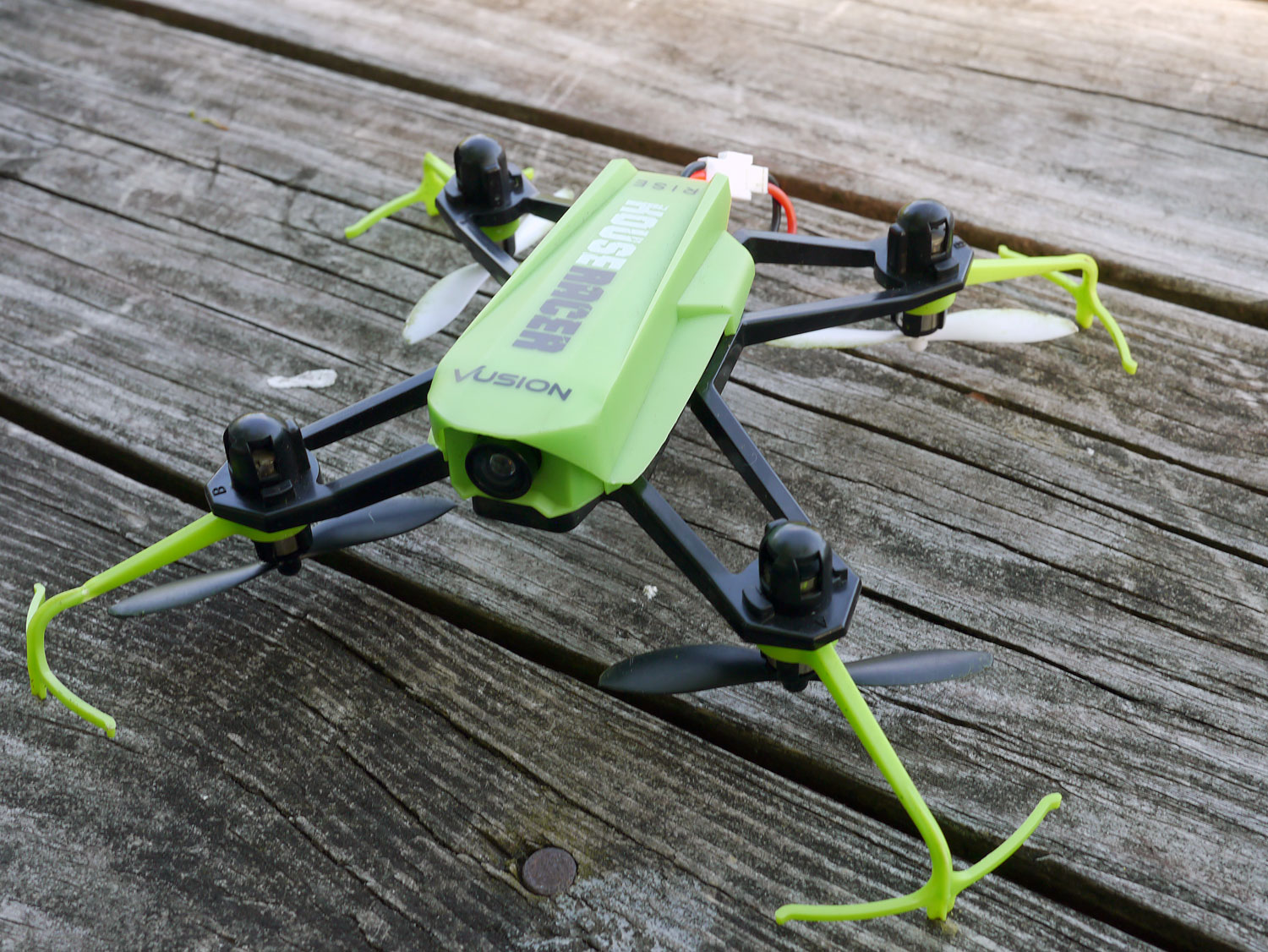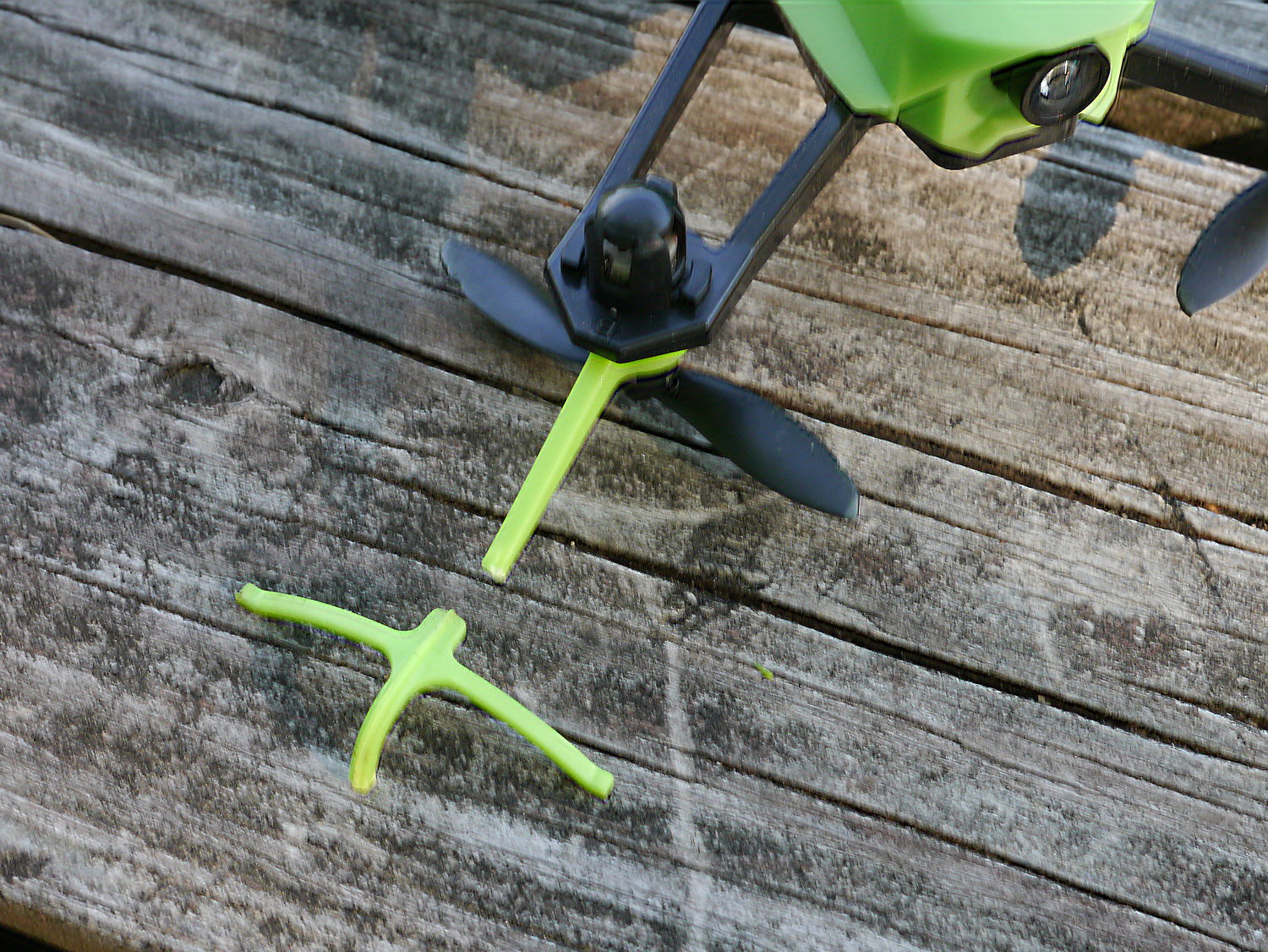Tom's Guide Verdict
The Vusion House Racer offers a great range of features for the price, but the video quality leaves a lot to be desired.
Pros
- +
Well-priced
- +
Fast
- +
Maneuverable
Cons
- -
FPV headset is of mediocre quality and fit
- -
Video gets glitchy at beyond about 20 feet
Why you can trust Tom's Guide
How you feel about drones buzzing around your house probably depends which side of the generation gap you reside. Kids love the idea, but parents aren't generally in favor. The Vusion House Racer tries to satisfy both parties with an FPV (first-person view) drone that offers speed and maneuverability, but which won't destroy your family heirlooms in the process. The House Racer does a pretty good job of keeping both sides of this ongoing family dynamic happy; it's a fun, nippy drone to fly (especially with the FPV headset), but it's small, light and well-protected enough that it won't break things.
Design
The House Racer is a slightly unusual-looking drone, in that most drones put the rotor blades above the drone body. Instead, the blades on this 6.5-inch square drone point downward. This orientation can make the drone more responsive and faster, but it also means that the rotors are more prone to getting caught on things. Start this drone in a grassy field, and you are likely to end up with blades of grass tangled in the motors
Above, the House Racer body has a small, wide-angle camera lens pointing forward out of its lime-green casing. At the back of the body is the cavity where the small, 650-mAh lithium polymer battery fits. There's no power switch; just plug the battery in, and the drone powers on.
The House Racer is a fun drone to fly, with plenty of speed and maneuverability to zip around the place.
A single red LED on the back of the drone body shows the status of the drone, blinking when the craft is waiting for the controller and solid when the drone is connected to the controller. Overall, it's a compact package that weighs in at just under 2.5 ounces, complete with battery.
Controller
The House Racer's controller is slightly larger than the drone and has two control sticks. The left stick controls altitude and rotation, while the right controls left-right and front-back movement. In addition, a switch on the controller's left shoulder changes the flight mode, while another one, on the right, controls the stunts that the drone can perform. Two additional shoulder buttons trigger video and photo capture.
Screen & FPV Headset
The preview of the video appears on a 4.5-inch LCD display that clips on top of the controller. A microSD card slot on one side stores video or still images, but no SD card is included. This display can also be installed into the included FPV headset, a rather bulky and uncomfortable affair that completely covers the eyes.
This isn't a binocular headset, though. You don't get the additional immersive effect of a separate image fed to each eye that many FPV headsets offer. Instead, using the House Racer is rather like holding the screen about a foot in front of your eyes and draping a cloth over your head. I also found that the band that holds the goggles on your head was rather tight (although I do have a bigger head than the younger users the House Racer designers have in mind).
Get instant access to breaking news, the hottest reviews, great deals and helpful tips.
Video captured by the House Racer looks like it was shot by an older camcorder.
The controller and drone communicate over the 2.4GHz frequency band, while the analog video signal is sent to the display on the 5.8GHz band. This means that while the video tends to get glitchy and fuzzy at about 20 feet, the drone can still be controlled out to 30 or 40 feet away. Because the video is recorded to SD card by the display, though, the recordings of your flights can be lost a little too easily if the drone is too far away to receive the signal.
Flying
The House Racer is a fun drone to fly, with plenty of speed and maneuverability to zip around the place. It's pretty fast, but the drone is rather sensitive; you'd be best served practicing outside before you try around-the-house flying. Once you get a feel for how to fly the House Racer, you can pull off some impressive maneuvers.

The drone offers three flight modes. Flight Mode 1 auto-levels the drone and limits the turning, movement and flight speed to fairly slow. Flight Mode 2 removes these limitations, but retains the auto-level feature. In Flight Mode 3, you are on your own, with total control over the drone. Flight Mode 1 is definitely the place to start, as the auto-levelling makes it much easier to recover: Just release the control sticks, and the drone will stop, level itself and hold still.

Flying the House Racer through the FPV headset requires a lot of practice. Apart from the uncomfortable headset, the sometimes-poor video quality makes it difficult to orient yourself by looking for landmarks, and the blurry video while the drone is turning or moving fast makes judging stops and turns hard. I definitely would not recommend using the FPV headset without a friend to act as spotter and warn you if you are about to hit a tree.
Photos & Video
The video and photos that the House Racer captures are of decent, but not spectacular quality. Images are high in resolution (1280 by 726 pixels for both video and stills), but the camera produces rather flat, dull colors and not much detail. It looks like video from an older analog camcorder. The camera lens has a nice wide angle (about 160 degrees of view), so you do get to see pretty much everything that is in front of the drone.
The wide angle also improves the feeling of speed in video. When you fly fast just above the ground, things looks dizzyingly quick. However, you don't get to see much detail and the the video becomes a blurry mess when the drone is turning at speed. If there is signal interference, or if the drone gets too far away, the video becomes staticky and fuzzy, like a poorly tuned old-school analog TV. Compared to the digitally transmitted video of rival drones like the Aerix Black Talon 2.0, the video of the House Racer looks weak.
Repairability
The House Racer is a light, but somewhat fragile drone. It bounced away from many collisions, escaping damage, as did most of the things that it crashed into. We did find that the rotor blade protectors were easily bent in a crash, pushing them into the path of the rotors and possibly damaging the fragile edge of the blade. The soft, plastic rotors are also somewhat prone to damage. A heavy landing on rocky ground left them with nicks and gouges that required replacement. Spare parts (such as for the propellor blades, canopy or motors) are easily available and well-priced, though.
Battery Life
The drone is powered by a small, gum-size, 650mAh Li-ion battery, which provides about 4 to 5 minutes of flight time, similar to what you get on the Black Talon 2. The battery is recharged from a USB port using the included charger, a process that takes about 20 minutes. Spare batteries are available for about $10.
Bottom Line
The Vusion House Racer has a slightly deceptive name. I certainly wouldn't send it racing around my house without getting a fair bit of practice outside first. Plus, the buzzing noise scared my dog, who normally reacts to drones with the indifference of a beast who has been overflown by many drones before.
Once you get a feel for the House Racer, though, it is quite maneuverable and fun to fly, and the different flight modes can take you from beginner to experienced pilot. The video and FPV headset aren't great in terms of quality, but they capture the feeling of flying quite well. Overall, the House Racer is a good pick for the aspiring pilot (especially at $180), but make sure you get some practice outdoors before taking to the friendly skies inside.
Richard Baguley has been working as a technology writer and journalist since 1993. As well as contributing to Tom's Guide, he writes for Cnet, T3, Wired and many other publications.

